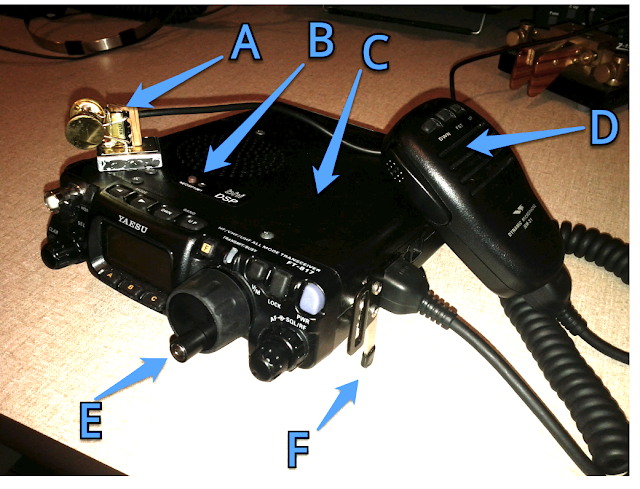How to trick-out a portable ham radio
As I’ve mentioned before, I’m very much into the portable, low-power subculture of amateur radio. On business trips, I like to find random hilltops (just like my mentor does), set up a simple vertical whip antenna, and then use my tiny battery-powered radio to start chatting with people around the country. It’s really quite a thrill.
The Yaesu FT817-ND is a really popular radio for this kind of thing. It’s tiny, battery-powered, only weighs a couple of pounds, and puts out 5 watts of power. Backpackers and hikers love it. That said, there’s still a huge aftermarket of “mods” you can add-on to make it more pleasureable to use. I thought I’d share some of these mods here with other aspiring low-power hams.

Here’s a guide to the different additions:
- A: Bulldog morse code paddles. These tiny paddles are made from sewing notions (buttons) and a tiny binder clip but work great and have a magnetic base that sticks to the radio. They’re no longer made, but a newer version screws to the side of the radio.
- B: DSP noise filter. This is an internal module installed for me by the fine folks at W4RT, who specialize in 817 upgrades. It almost completely destroys the static noise floor, just like the noise reduction in my big radio. The change is dramatic and invaluable.
- C: 300hz CW filter Just a standard mechanical Collins filter for making morse-code much more intelligible; offered as an accessory directly from Yaesu.
- D: Speech compressor. Another W4RT mod installed within the hand microphone, it supposedly emphasizes the mids and trebles of the human voice, making my voice much more intelligible to others when using SSB over 5 watts. Others have told me that I sound really clear with it!
- E: Kranker knob. Another W4RT mod which makes the main dial much more usable — both for fine and rapid coarse-tuning.
- F: Peg legs. Cute little foldable feet from Palm Radio, which tip the radio upwards towards your eyes. It’s amazing what an ergonomic difference this makes.
Of course, once I’m actually in the field, I use an Elecraft T1 tuner (about the size of a deck of cards!), and an A123 nanophosphate 4.6AH battery for up to 8 hours of operation in the field.

I used to have a ft-817 great radio sorry i sold it now…David VK4DJC.